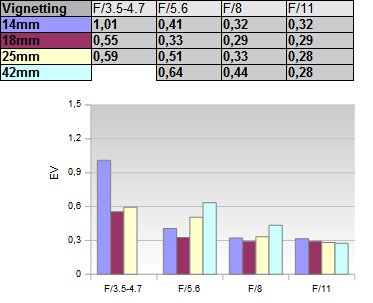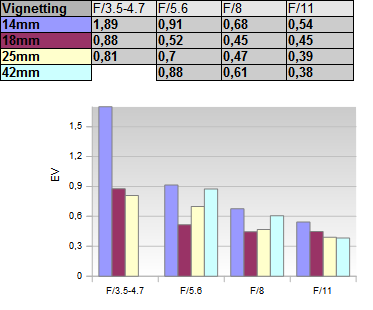|
Olympus M.Zuiko 14-42mm f/3.5-5.6 ED EZ - Review / Test Report - Analysis |
|
Lens Reviews -
(Micro-)Four-Thirds
|
|
Page 2 of 3

Distortion
The image distortion produced by micro 4/3 images is auto-corrected either directly in the camera (JPEGs) or in most RAW-converters. The "exposed" distortion is therefore marginal across the range.
However, the non-corrected raw images show a different situation with an extreme (~5.6%) barrel distortion at 14mm changing to a moderate (1.5%) pincushion distortion at 42mm.
If you move your mouse cursor over the image you can switch to the corresponding non-corrected results.
Vignetting
The Olympus lens has an average vignetting characteristic although it's not all that bad in auto-corrected mode. At 14mm and f/3.5 the amount of vignetting is around ~1EV which will be noticeable in field images. Nevertheless, the situation improves significantly when stopping down and the light falloff is just slightly noticeable from f/5.6 onwards and substantially reduced in the middle range. At 42mm f/5.6 the issue is getting a bit more obvious again without being really disturbing.
 However, it's no surprise that the non-corrected images show consistently worse results particularly at 14mm. This is mostly related to the lack of cropping with disabled distortion correction.
However, it's no surprise that the non-corrected images show consistently worse results particularly at 14mm. This is mostly related to the lack of cropping with disabled distortion correction.

MTF (resolution)
The resolution figures of the lens are a bit of a mixed bag. The center performance is high at 14mm and 18mm. However, the outer image region isn't overly impressive especially at 14mm. Unfortunately stopping down doesn't really improve the situation in the corners here. The sweet spot of the lens is at 25mm with a good to very good quality across the range even at max. aperture. At 42mm there's a slight penalty but the lens is still capable of achieving good results. Diffraction effects have a higher impact from f/11 onward so you should avoid such settings unless really needed.
The tested sample showed a slight centering defect on the left side of the image. This is rather unusual for an Olympus lens.
Please note that the MTF results are not directly comparable across the different systems!
Below is a simplified summary of the formal findings. The chart shows line widths per picture height (LW/PH) which can be taken as a measure for sharpness.
If you want to know more about the MTF50 figures you may check out the corresponding Imatest Explanations

Chromatic Aberrations (CAs)
Lateral chromatic aberrations (color shadows at harsh contrast transitions) are not really a strength of the Olympus lens. The issues isn't overly pronounced at max. aperture. However, at 14mm and 18mm the CA increase sharply towards medium aperture settings. The 25mm and 42mm settings aren't quite as affected.

|